This article was co-authored by wikiHow Staff. Our trained team of editors and researchers validate articles for accuracy and comprehensiveness. wikiHow's Content Management Team carefully monitors the work from our editorial staff to ensure that each article is backed by trusted research and meets our high quality standards.
There are 11 references cited in this article, which can be found at the bottom of the page.
wikiHow marks an article as reader-approved once it receives enough positive feedback. This article received 22 testimonials and 82% of readers who voted found it helpful, earning it our reader-approved status.
This article has been viewed 3,670,553 times.
Learn more...
If you’re a gender-diverse individual, tucking can help you feel more comfortable with your body. Whether tucking helps affirm your gender identity as trans, agender, or nonbinary, or you want to learn how to tuck for drag, we've got you covered. Read on for the safest ways to tuck with tape as well as how to untuck. We've also got the best alternatives to tucking tape, from bikini bottoms to gaffs, so you can feel comfortable and empowered.
Steps
Tucking with Tape
-
1Shave your pubic hair if you plan on using tape. Use a good razor and shaving cream or gel to shave the scrotum and surrounding area. Carefully hold your skin so it’s tight and flat, shave slowly and gently with the grain, and rinse the razor every 1 to 2 strokes. When you’re finished, lightly apply baby oil, Aloe, or a gentle, unscented moisturizer.[1]
- It’ll be easier to remove the tape if you’ve shaved your pubic hair. Shave at least 1 or 2 days prior to tucking and taping. Do not tape freshly shaved skin.
- If necessary, carefully pre-trim pubic hair with an electric trimmer.
-
2Slide the testes between your legs for the easiest method. Carefully pull the testes and scrotum between your legs toward your buttocks. If possible, place them between or under your buttocks to obscure them. Later, you can hold them in place by tugging the penis between your legs and securing the area with tape or tight underwear.[2]
- Pulling the external genitals between your legs is the simplest method, but it may not yield the flattest appearance. To obscure them more thoroughly, some people prefer to tuck the testes up into the pelvic floor.
Advertisement -
3Lift the testes into the inguinal canals to obscure them completely. There’s a socket in the pelvic floor above each testicle called the inguinal canal. For the flattest appearance, lie on your back and, using 2 or 3 fingers, gently shift the testes upward and into each socket. Guide them slowly, do not use hard pressure, and stop tucking if you experience pain.[3]
- Taking a cold bath or shower before tucking may make the process easier. The testes naturally ascend toward the inguinal canals when they're exposed to cold temperatures.[4]
- Note that tucking the testes into the inguinal canals for prolonged periods can raise their temperature, which may lead to fertility issues.[5]
- You may not need to use tape to tuck–that's up to you![6]
-
4Cover the tip of the penis with gauze or toilet paper before tucking it. Hold the tucked testes in place as you wrap gauze, toilet paper, or a piece of paper towel over the head of the penis. Be sure to cover the opening of the urethra, or the hole that releases urine.[7]
- Tucking the penis back toward the anus can lead to infection. Covering the tip of the penis helps prevent germs from entering the opening of the urethra.
- It’s also wise to regularly apply antifungal powder to the area to prevent infections and odor.
-
5Pull the scrotum and penis between your legs gently. Continue to hold the testes in place with 1 hand. Carefully tug the penis down and back toward the space between your buttocks. Pull it snugly, but take care not to hurt yourself. You shouldn’t feel any pain, numbness, or throbbing.[8]
- While holding your tucked external genitals in place, check the skin for paleness or bluish or purple discoloration. If you experience numbness, throbbing, and discoloration, you may have cut off circulation and should untuck your genitals.
-
6Cover your tucked genitals with 2 to 3 layers of medical tape. Hold your tucked genitals in place with 1 hand, then apply strips of medical tape over your pelvic floor and the shaft of the penis.[9]
- Do not use duct, scotch, or any tape other than medical tape. Other types of tape can damage your skin.
- Make sure the area is dry before you start tucking so the medical tape adheres. If you sweat during the process, pat the area dry with a towel.[10]
-
7Pass the tape around your hips or up your lower spine. Keep holding the tucked area after covering it with strips of medical tape to ensure everything stays in place. Stick tape to the left side of your pelvic floor over the area you’ve already covered with tape. Run it around the underside of your left buttock to your left hip, then pass another strip of tape on the right side to your right hip.[11]
- Alternatively, if your hips will be visible, run tape from your pelvic floor to your tailbone.
- Make sure everything stays in place, then promptly put on underwear or a gaff. You may find it helpful to put on your undergarments and keep them around your knees or shins while you tuck and tape.
-
8Soak the area in warm water and peel the tape gently when you untuck. When the time comes to untuck, take a shower or bath, or soak the area with a wet washcloth. Once the tape is wet, peel it off carefully and slowly to avoid hurting your skin.[12]
- After removing the tape, allow your external genitals to return to their normal position. Then wash the area well, as dampness that collects beneath the tape promotes germs and odor.
- You may have to guide the testicles back out of the inguinal canals with your fingers.
-
9Exercise caution and tuck carefully to avoid injury. Tucking can lead to a variety of issues, including pain, skin irritation, damage to the genitals, urinary trauma, and infection. Handle your body gently when you tuck, stop what you’re doing if you experience pain, and talk to a healthcare provider if you’re concerned about the medical risks of tucking.[13]
- If you don’t have immediate access to a gender-affirming healthcare provider, look online to find a local transgender resource center.
Safety precaution: Prolonged tucking increases the risk of complications. Avoid tucking for longer than 8 hours at a time, and keep your genitals untucked for extended periods every day, such as while you sleep.
Trying Alternatives to Tape
-
1Experiment with tight-fitting underwear or shapewear. Try tucking your external genitals, then put on underwear that’s 1 to 2 sizes too small. For best results, choose garments made of elastic material instead of cotton. You could also try wearing 2 pairs of underwear, wear tight pantyhose over underwear, or hold everything in place with a compression undergarment.[14]
- Bikini swimsuit bottoms are popular alternatives to tape in the drag community. They’re usually made of tightly woven spandex, which is better because natural fibers like cotton or silk can be “slippery” and cause things to move out of place.[15]
- Play around with combinations of underwear and shapewear until you’ve achieved your desired results. Keep in mind your undergarments shouldn’t cause pain or cut off your circulation.
- It's possible to position and tape your body parts in a way that allows you to use the restroom. However, when it comes to going to the bathroom, wearing undergarments is more convenient than taping.
-
2Try wearing a gaff. You can purchase gaffs, or panties made especially for tucking, online and specialty stores. Gaffs are worn just like underwear, but they’re made of an elastic material that’s strong enough to hold the tuck in place.[16]
- While gaffs are an effective option, many people find them too uncomfortable to wear every day. Additionally, they tend to be a lot more expensive than regular underwear.[17]
-
3Invest in a garment specially designed for gender-diverse individuals. Specialty products are available online that hold the tuck more comfortably than gaffs. Additionally, some garments are designed to mimic the appearance of a vulva. On the downside, these products can be hard to find, and they can cost anywhere from $100 to $500 (U.S.).[18]
Tip: If you’re gender-diverse, tucking and wearing garments that affirm your identity can have major positive impacts on mental health. If you need help paying for garments, your local trans health resource center may offer financial assistance.
Tucking for Drag
-
1Wait to tuck until you’re 100% ready to put on your outfit. Tucking can make it harder to sit comfortably (and it definitely makes it harder to pee). The tucking process will only take about 30 seconds once you’ve practiced it, so wait to tuck and throw on your gaff until right before your performance.[19]
-
2Keep in mind using the restroom might get complicated. You’ll have to untuck to pee, and you likely won’t get as clean of a tuck afterward. How do drag queens make it through long 2-3 hour performances? Many simply wait until after their show to untuck and use the restroom.[21]
- Look out for yourself by staying hydrated and untucking when you do need to pee.[22]
-
3Put on at least one pair of tights. Wearing tights over your gaff or swimsuit bottoms makes sure that everything stays tucked. You can go up to 3 pairs of tights if you want. Don’t worry about things becoming untucked during your performance–it likely won’t happen if you have tights on.[23]
-
4Wear skirts and dresses if tucking is uncomfortable. The whole point of tucking is for you to feel empowered and comfortable in your body! Tucking doesn’t feel right for everyone’s body, and you can still be a fabulous drag queen without tucking–some drag queens opt for swimwear bottoms but don’t tuck. If that sounds like you, go untucked and throw on a beautiful skirt or dress to rock the stage.[24]
Community Q&A
-
QuestionI'm afraid of tucking my testicles. Does it hurt?
 Community AnswerIt can be initially uncomfortable but no it doesn't hurt when done correctly.
Community AnswerIt can be initially uncomfortable but no it doesn't hurt when done correctly. -
QuestionCan transgender girls use women's toilets?
 Community AnswerIt varies from state to state. The majority of places allow trans people to use the bathroom of their current gender.
Community AnswerIt varies from state to state. The majority of places allow trans people to use the bathroom of their current gender. -
QuestionHow do I sleep while tucking?
 Definitely cilantroCommunity AnswerYou probably shouldn't, as this can cause problems. Try something else, such as wearing cute pajamas to relieve dysphoria instead.
Definitely cilantroCommunity AnswerYou probably shouldn't, as this can cause problems. Try something else, such as wearing cute pajamas to relieve dysphoria instead.
Warnings
- Consult a gender-affirming healthcare provider if you experience pain or any other concerning symptoms related to tucking.⧼thumbs_response⧽
- There isn’t much research on the long-term safety of tucking, so it’s best to consult your doctor before tucking, especially if you plan on doing it on a routine basis.[25]⧼thumbs_response⧽
References
- ↑ https://www.suny.edu/media/suny/content-assets/documents/spectrum/presentations/Culturally-Responsive-Care-for-Transgender-Patients-pt-2.pdf
- ↑ https://pediatrics.med.ufl.edu/files/2018/03/Tucking-Handouts-Youth.pdf
- ↑ http://www.phsa.ca/transcarebc/care-support/transitioning/bind-pack-tuck-pad
- ↑ https://www.daphealth.org/wp-content/uploads/2020/07/Safer-Tucking-Brochure.pdf
- ↑ https://smartsexresource.com/health-providers/blog/201610/addressing-tucking-transgender-and-gender-variant-patients
- ↑ https://www.daphealth.org/wp-content/uploads/2020/07/Safer-Tucking-Brochure.pdf
- ↑ https://www.suny.edu/media/suny/content-assets/documents/spectrum/presentations/Culturally-Responsive-Care-for-Transgender-Patients-pt-2.pdf
- ↑ http://www.phsa.ca/transcarebc/care-support/transitioning/bind-pack-tuck-pad
- ↑ https://pediatrics.med.ufl.edu/files/2018/03/Tucking-Handouts-Youth.pdf
- ↑ https://www.suny.edu/media/suny/content-assets/documents/spectrum/presentations/Culturally-Responsive-Care-for-Transgender-Patients-pt-2.pdf
- ↑ https://www.suny.edu/media/suny/content-assets/documents/spectrum/presentations/Culturally-Responsive-Care-for-Transgender-Patients-pt-2.pdf
- ↑ https://www.healthline.com/health/transgender/tucking#how-tountuck
- ↑ http://transhealth.ucsf.edu/trans?page=guidelines-testicular-pain
- ↑ https://pediatrics.med.ufl.edu/files/2018/03/Tucking-Handouts-Youth.pdf
- ↑ https://pointofpride.org/gaffs-101-tucking-safely-and-comfortably/
- ↑ https://www.suny.edu/media/suny/content-assets/documents/spectrum/presentations/Culturally-Responsive-Care-for-Transgender-Patients-pt-2.pdf
- ↑ https://www.theguardian.com/lifeandstyle/2015/sep/24/underwear-for-transgender-people-shapewear
- ↑ https://www.theguardian.com/lifeandstyle/2015/sep/24/underwear-for-transgender-people-shapewear
- ↑ https://www.phillyvoice.com/infrequently-asked-questions-drag-tuck/
- ↑ http://www.phsa.ca/transcarebc/Documents/HealthProf/Tucking-Handout.pdf
- ↑ https://www.phillyvoice.com/infrequently-asked-questions-drag-tuck/
- ↑ http://www.phsa.ca/transcarebc/Documents/HealthProf/Tucking-Handout.pdf
- ↑ https://www.phillyvoice.com/infrequently-asked-questions-drag-tuck/
- ↑ https://www.phillyvoice.com/infrequently-asked-questions-drag-tuck/
- ↑ https://pediatrics.med.ufl.edu/files/2018/03/Tucking-Handouts-Youth.pdf
About This Article
To tuck and tape, start by shaving the scrotum and surrounding area so the tape doesn't pull the hair out. Next, slide the testes and scrotum carefully between your legs toward your buttocks. If possible, place them between or under your buttocks to obscure them. Then, place gauze or toilet paper over the head of the penis, tug it down and back toward the space between your buttocks, and cover your tucked genitals with 2 to 3 layers of medical tape to hold them in place. For tips on removing tape painlessly, read on!
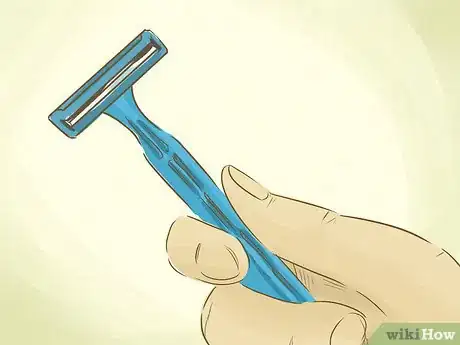

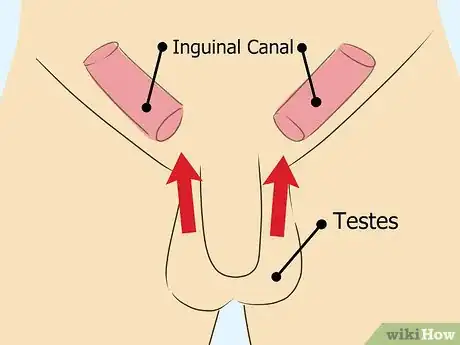
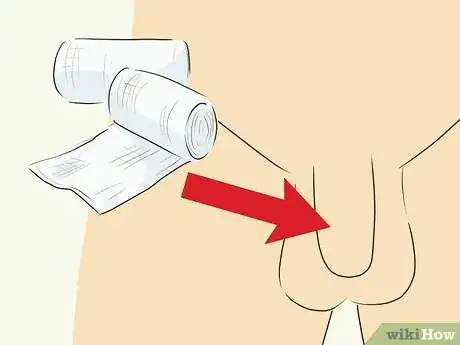
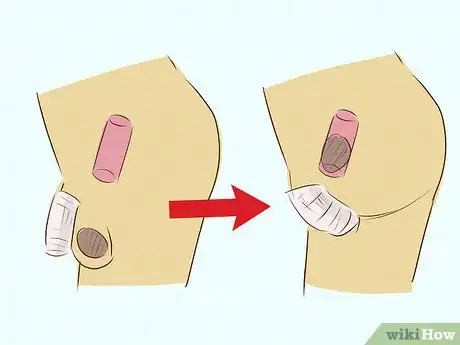



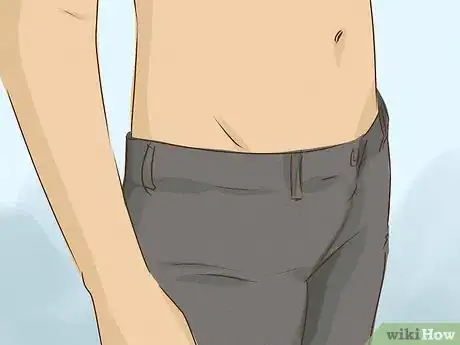

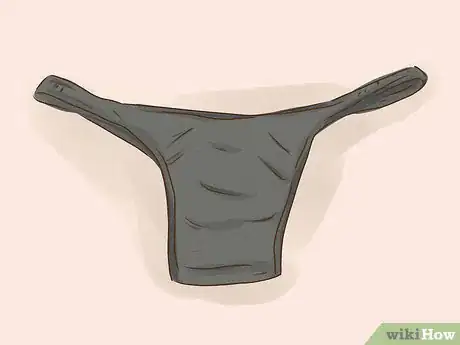
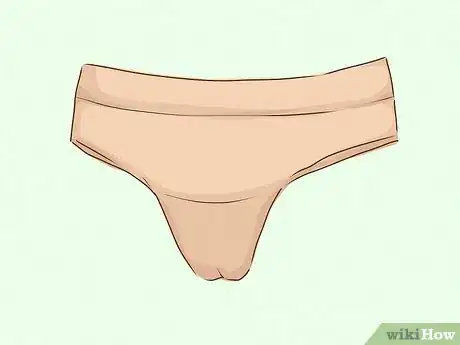

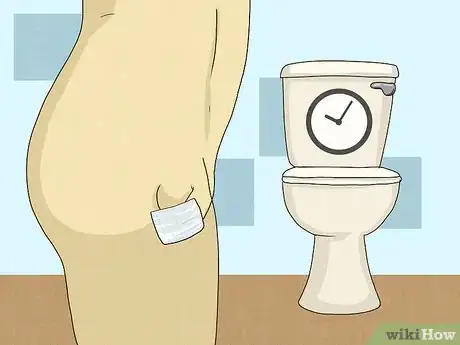
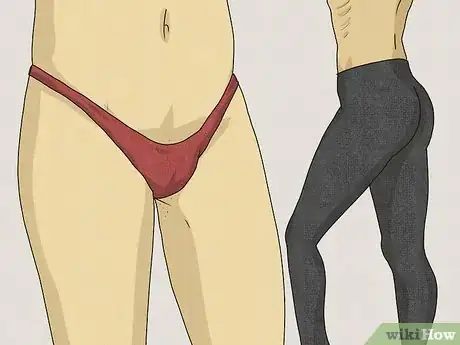




-Step-16.webp)
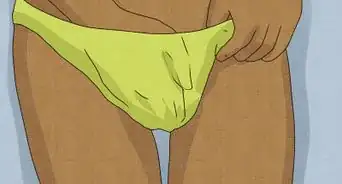


-Step-26.webp)
-Step-16.webp)

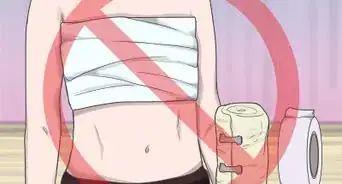
















-Step-16.webp)



































